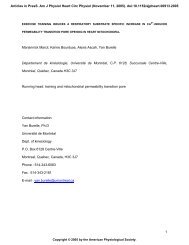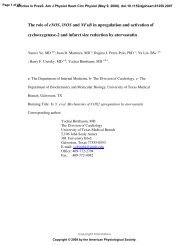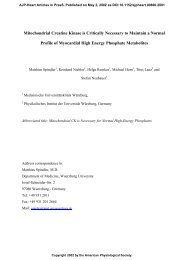Overexpression of 1B-adrenergic receptor induces left ventricular ...
Overexpression of 1B-adrenergic receptor induces left ventricular ...
Overexpression of 1B-adrenergic receptor induces left ventricular ...
Create successful ePaper yourself
Turn your PDF publications into a flip-book with our unique Google optimized e-Paper software.
and afterload, LVP was drastically reduced in the<br />
transgenic hearts. Analysis <strong>of</strong> the myocardial contractile<br />
parameters (Table 2) showed that LVP was reduced<br />
by 20 mmHg, whereas both diastolic and enddiastolic<br />
pressure were significantly increased. Left<br />
atrial pressure was also significantly increased. In the<br />
transgenics, peak LV dP/dt was reduced by 32% <strong>of</strong><br />
control, and TPP was prolonged by 48%. Peak LV<br />
dP/dt was decreased by 42% <strong>of</strong> control. Similarly,<br />
RT 1/2 was prolonged by 66%. These data indicate that<br />
Table 2. Cardiac performance in the working-heart<br />
preparation at controlled pre- and afterload conditions<br />
Control Transgenic<br />
P<br />
Value<br />
Minute work,<br />
ml·min 1 ·mmHg 2497.1 251.1.01 0.79<br />
HR, beats/min 31724 31515 0.93<br />
LVP, mmHg 104.91.5 83.31.0 0.0001<br />
LVDP, mmHg 5.90.9 0.90.5 0.0001<br />
LVEDP, mmHg 8.90.7 13.80.5 0.0001<br />
LAP, mmHg 7.90.9 12.41.2 0.004<br />
Peak dP/dt, mmHg/s 3,78066 2,60061 0.0001<br />
Peak dP/dt, mmHg/s 3,239101 1,90681 0.0005<br />
TPP, ms/mmHg 0.4310.007 0.6400.012 0.0001<br />
RT½, ms/mmHg 0.4790.014 0.7970.026 0.0004<br />
Coronary flow, ml/min 2.670.64 3.161.34 0.11<br />
Values are means SE; control group contained 4 female and 5<br />
male animals, and transgenic group contained 4 female and 4 male<br />
animals. Definitions are as in Table 1. Hearts were excised and<br />
cannulated through a pulmonary vein and aorta for a workperforming<br />
preparation. LVP was measured continuously by a fluidfilled<br />
catheter connected to a pressure transducer. Derivatives <strong>of</strong> LVP,<br />
as well as time to peak pressure (TPP) and half-time <strong>of</strong> relaxation<br />
(RT½), were calculated. Coronary flow was determined by collecting<br />
perfusate on a digital electronic balance. All parameters were determined<br />
at identical preload and afterload conditions, which is reflected<br />
in comparable values for minute work.<br />
LV DYSFUNCTION IN CARDIAC <strong>1B</strong>-AR OVEREXPRESSION<br />
H1341<br />
Fig. 1. Polygraph tracing <strong>of</strong> work-performing<br />
perfused hearts. Contractile parameters were<br />
determined in isolated, anterogradely perfused<br />
hearts. Representative traces obtained<br />
from a control (<strong>left</strong>) and transgenic (right)<br />
animal are shown. LVP, <strong>left</strong> intra<strong>ventricular</strong><br />
pressure; dP/dt, first derivative <strong>of</strong> LVP over<br />
time; LV, <strong>left</strong> <strong>ventricular</strong>.<br />
both systolic and diastolic LV functions are compromised<br />
in the transgenic hearts. These measurements<br />
are similar in direction and magnitude to the results<br />
obtained in the anesthetized closed-chest model. Hearts<br />
isolated from line Tg43 displayed a comparable reduction<br />
<strong>of</strong> LV contractile function in the perfusion preparation<br />
(data not shown), indicating that the observed<br />
phenotype is not due to integration site effects <strong>of</strong> the<br />
transgene. Further experiments were therefore carried<br />
out with animals from line Tg47.<br />
Positive inotropic response to 1-AR stimulation in<br />
the mouse heart. Varying effects on inotropy by 1-AR<br />
agonists have been described. We therefore wanted to<br />
determine the response <strong>of</strong> mouse hearts to phenylephrine,<br />
an 1-AR agonist. Hearts from control animals<br />
were perfused anterogradely with increasing doses <strong>of</strong><br />
phenylephrine. As shown in Fig. 2, a trend toward<br />
increased peak dP/dt and dP/dt was observed. Similarly,<br />
TPP and RT 1/2 were shortened. A positive chronotropic<br />
response (130% <strong>of</strong> baseline) was also observed.<br />
This experiment demonstrates that in the perfused<br />
mouse heart 1-AR stimulation results in positive<br />
inotropic and chronotropic responses.<br />
Increased inotropy by the -AR agonist isoproterenol.<br />
Agonist-mediated stimulation <strong>of</strong> -AR has a positive<br />
inotropic and chronotropic effect. To test if <strong>1B</strong>-AR<br />
overexpression modulates the heart’s response to -AR<br />
stimulation, work-performing perfused hearts were<br />
challenged with increasing doses <strong>of</strong> the -AR agonist<br />
isoproterenol. No adverse effects were elicited by the<br />
process <strong>of</strong> infusion itself (see suboptimal doses in Fig.<br />
3). In controls, the expected dose-dependent positive<br />
inotropic and chronotropic responses were observed.<br />
The increase in heart rate was accompanied by an<br />
increase in dP/dt and dP/dt (Fig. 3, B and C) and a<br />
Downloaded from<br />
http://ajpheart.physiology.org/<br />
by guest on June 28, 2013






